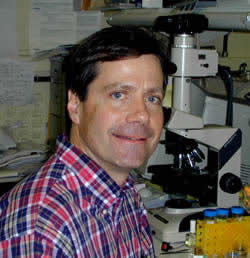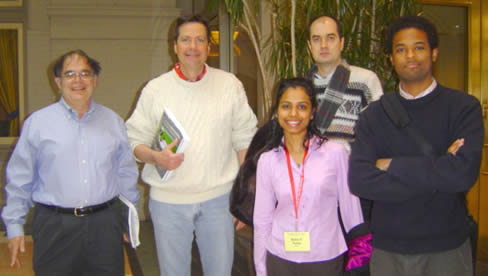| |
| |
| Ward F. Odenwald, Ph.D., Investigator |
 |
Dr. Odenwald received his Ph.D. degree in Biology from Johns Hopkins University. His postdoctoral work on the functional analysis of the murine homeobox gene Hox A.5 was carried out in the laboratory of Robert Lazzerini at the NINDS. In 1990, he established the Neurogenetics Unit in the Laboratory of Neurochemistry, NINDS, where he has pursued the identification and functional analysis of neuronal-identity networks that control stem cell lineage development in the CNS. Dr. Odenwald's laboratory is currently studying the role of transcription factor regulatory networks that participate in the development of Drosophila CNS ganglia.
|

|
Staff:

Research Interests:
In a developing nervous system, the precise timing of cell identity decisions is most likely under the combinatorial control of cell-extrinsic and cell-intrinsic regulatory inputs. To understand how these orchestrated events collectively produce a functioning nervous system it is necessary to characterize the genetic circuitry underlying the patterning of cell-fate determining events. Given the remarkable gene conservation observed among all metazoa, we believe that understanding the molecular details of Drosophila CNS lineage development will have broad implications for vertebrate neurogenesis. Our studies reveal that there exists a cell-identity regulatory network that acts temporally during the formation of all CNS ganglia. We have discovered that during neural precursor cell lineage development most neuroblasts undergo sequential transitions in the expression of a set of transcription factors: As a result sequentially formed neuronal subpopulations arise that are marked by the expression of one of these factors. Given the global nature of this regulatory cascade, we hypothesize that these expression domains represent fundamental branch points in the developmental programs that control cell-fate decisions in all CNS ganglia.
To gain insight into how neuroblasts transition from one developmental program to the next, we have focused our research efforts on the identification and functional analysis of gene regulatory DNA regions, called enhancers, that control the expression of these transcription factor genes. Thus far, we have discovered that each factor is regulated by multiple enhancers that control different aspects of their expression (view examples at our cisPatterns web site). Using multi-genome DNA alignment programs, developed by in our lab: EvoPrinter and cis-Decoder, we have taken advantage of the cumulative evolutionary DNA sequence divergence that exists among species to identify highly conserved DNA sequences within each of the enhancers. Mutational analysis of these sequences reveals that each is required by normal gene control. Currently, we are adapting our comparative genomic tools so other scientists can use them to study vertebrate enhancers. To learn more about how EvoPrints help us identify important DNA sequences, visit the NIH Evolution and Medicine tutorial.
|
Selected Recent Publications:
Kuzin, A., Kundu, M., Ross, J., Koizum,i K., Brody, T. and Odenwald, W.F. (2012) The cis-regulatory dynamics of the Drosophila CNS determinant castor are controlled by multiple sub-pattern enhancers, Gene Expression Patterns 9;12(7-8), 261-272.
Full Text/Abstract
Brody, T., Yavatkar, A.S., Kuzin, A., Kundu, M., Tyson, L.J., Ross, J., Lin, T.Y., Lee, C.H., Awasaki, T., Lee, T. and Odenwald, W.F. (2012) Use of a Drosophila genome-wide conserved sequence database to identify functionally related cis-regulatory enhancers, Developmental Dynamics 241, 169-189.
Full Text/Abstract
Roessler, E., Hu, P., Hong, S.K., Srivastava, K., Carrington, B., Sood, R., Petrykowska, H., Elnitski, L., Ribeiro, L.A., Richieri-Costa, A., Feldman, B., Odenwald, W.F. and Muenke, M. (2012) Unique Alterations of an Ultraconserved Non-Coding Element in the 3'UTR of ZIC2 in Holoprosencephaly, PLoS One 7(7), e39026.
Full Text/Abstract
Kuzin A, Kundu M, Brody T, Odenwald WF (2011) Functional analysis of conserved sequences within a temporally restricted neural precursor cell enhancer., Mechanisms of Development 128, 165-177.
Full Text/Abstract
Kuzin A, Kundu M, Ekatomatis A, Brody T, Odenwald WF (2009) Conserved sequence block clustering and flanking inter-cluster flexibility delineate enhancers that regulate nerfin-1 expression during Drosophila CNS development., Gene Expr Patterns 9, 65-72.
Full Text/Abstract
Yavatkar A. S., Lin Y., Ross, J., Fann Y., Brody T. and Odenwald W. F. (2008) Rapid detection and curation of conserved DNA via enhanced-BLAT and EvoPrinterHD analysis., BMC Genomics 9, 106-118.
Full Text/Abstract
Brody T, Yavatkar AS, Lin Y, Ross J, Kuzin A, Kundu M, Fann Y, Odenwald WF (2008) Horizontal gene transfers link a human MRSA pathogen to contagious bovine mastitis bacteria., PLoS One 3, e3074.
Full Text/Abstract
All Selected Publications
Contact Information:
Dr. Ward F. Odenwald
Neural Cell-Fate Determinants Section, NINDS
Porter Neuroscience Research Center
Building 35, Room 1B-1014
35 Convent Drive, MSC 4130
Bethesda, MD 20892-4130
Telephone: (301) 402-1657 (office),
(301) 496-5940 (laboratory),
(301) 496-1339 (fax)
Email: odenwaldw@ninds.nih.gov
|
|















